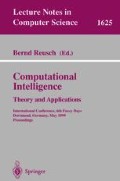Abstract
This paper deals with two aspects of the application of ART-MAP neural networks for classification of satellite images obtained by remote sensing of the Earth. The first part contains an analysis of the influence of data representation and cluster determination method on classification accuracy. Three types of representation/determination are analyzed. Best results are obtained for Gaussian ARTMAP, an ARTMAP neural network using gaussian distributions for identification of clusters in feature space. In the second part, a method for evaluation of the classification quality is described. This method introduces a confidence index which is assigned to each individual pixel of the image, thus allowing generation of a confidence map for the classified image. The confidence index is computed conveniently exploiting features of the Gaussian ARTMAP learning algorithm. Using a threshold determining the minimal required confidence, this method allows one to generate a map which shows only pixels with prescribed minimal confidence, effectively creating an additional class containing pixels classified with subthreshold confidence.
Access this chapter
Tax calculation will be finalised at checkout
Purchases are for personal use only
Preview
Unable to display preview. Download preview PDF.
References
G. A. Carpenter, M. N. Gjaja, S. Gopal, and C. E. Woodcock. Art neural networks for remote sensing: Vegetation classification from landsat tm and terrain data. IEEE Transactions on Geoscience and Remote Sensing, 35(2):308–325, 1999.
G.A. Carpenter and S. Grossberg. A massively parallel architecture for a self-organizing neural pattern recognition machine. Computer Vision, Graphics, and Image Processing, 37:54–115, 1987.
G.A. Carpenter, S. Grossberg, N. Markuzon, J.H. Reynolds, and D.B. Rosen. Fuzzy ARTMAP: A neural network architecture for incremental supervised learning of analog multidimensional maps. IEEE Transactions on Neural Networks, 3(5):698–713, 1992.
Gail Carpenter and Stephen Grossberg. Art 2: Self-organization of stable category recognition codes for analog input patterns. Applied Optics, 1987. Special issue on neural networks.
Gail A. Carpenter, Stephen Grossberg, and B. Rosen David. FUZZY ART: an adaptive resonance algorithm for rapid, stable classification of analog patterns. Technical Report CAS/CNS-TR-91-006, Boston University, 1991.
Gail A. Carpenter, Stephen Grossberg, and John Reynolds. ARTMAP: Supervised real-time learning and classification of nonstationary data by a self-organizing neural network. Neural Networks, 4:565–588, 1991.
R.O. Duda and P.E. Hart. Pattern Classification and Scene Analysts. Wiley, New York, 1973.
K. Fukunaga. Introduction to Statistical Pattern Recognition. Academic Press, San Diego, CA, 1972.
Stephen Grossberg. Adaptive pattern classification and universal recoding, I: Feedback, expectation, olfaction, and illusions. Biological Cybernetics, 23:187–202, 1976.
International Neural Network Society. Interactive Segmentation of Biomedical Images, Brno, Czech Republic, May 1998. Vitium Press. ISSN 1211-421X, ISBN-80-241-1169-4.
B. G. Lees and K. Ritman. Decision-tree and rule-induction approach to integration of remotely sensed and gis data in mapping vegetation in disturbed or hilly environments. Environmental Management, 15:823–831, 1991.
Robert J. Mokken. Remote sensing, statistics and artificial neural networks. Some R and D perspectives., 1995.
J. Richards. Remote sensing digital image analysis: An introduction. Springer-Verlag: Berlin, 1993.
P. Sinčák, H. Veregin, and N. Kopčo. Conflation techniques in multispectral image processing. Submitted to IJRS in February 1997, 1997.
P. Werbos. Beyond Regression: New Tools for Prediction and Analysis in the Behavioral Sciences. PhD thesis, Harvard University, 1974.
James R. Williamson. Gaussian ARTMAP: A neural network for fast incremental learning of noisy multidimensional maps. Neural Networks, pages 881–897, 9 1996.
Author information
Authors and Affiliations
Editor information
Editors and Affiliations
Rights and permissions
Copyright information
© 1999 Springer-Verlag Berlin Heidelberg
About this paper
Cite this paper
Kopčo, N., Sinčák, P., Veregin, H. (1999). Extended Methods for Classification of Remotely Sensed Images Based on ARTMAP Neural Networks. In: Reusch, B. (eds) Computational Intelligence. Fuzzy Days 1999. Lecture Notes in Computer Science, vol 1625. Springer, Berlin, Heidelberg. https://doi.org/10.1007/3-540-48774-3_24
Download citation
DOI: https://doi.org/10.1007/3-540-48774-3_24
Publisher Name: Springer, Berlin, Heidelberg
Print ISBN: 978-3-540-66050-7
Online ISBN: 978-3-540-48774-6
eBook Packages: Springer Book Archive

